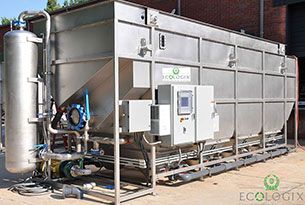
In today's industrial landscape, managing wastewater isn't just about compliance; it's about efficiency, sustainability, and cost savings. With stricter environmental regulations and growing demands for water reuse, businesses are constantly seeking advanced solutions. That's where Dissolved Air Flotation (DAF) and its Dissolved Air Flotation (DAF) systems come in. While DAF is a proven technology for removing suspended solids, oils, greases (FOG), and even some biochemical oxygen demand (BOD), simply buying any DAF won't cut it for complex industrial challenges.
This comprehensive guide will help you navigate the crucial decisions in selecting the optimal DAF system that not only meets your unique wastewater needs but also delivers significant return on investment (ROI).
Understanding Your Wastewater: The First Step to DAF Success
Before you even think about DAF models, the most critical step is a thorough understanding of your wastewater's characteristics. This isn't a one-size-fits-all solution; your influent quality will directly dictate the most effective DAF design.
- Flow Rates: Both average and peak flow rates (e.g., m³/h, GPM) are essential for sizing.
- Contaminant Profile:
- Total Suspended Solids (TSS): Concentration, particle size, and density.
- Fats, Oils, and Greases (FOG): Concentration, type (emulsified, free-floating), and temperature.
- Biochemical Oxygen Demand (BOD) / Chemical Oxygen Demand (COD): While DAF primarily removes particulate BOD, understanding overall organic load is key for integrated systems.
- pH and Temperature: Crucial for chemical coagulation/flocculation effectiveness.
- Specific Contaminants: Heavy metals, surfactants, or other unique pollutants that might impact flotation or require pre-treatment.
The best DAF suppliers will emphasize the importance of treatability studies. These services provide invaluable data, confirming the DAF's performance with your actual wastewater and allowing for precise system sizing and chemical optimization, minimizing costly surprises down the line.
Key DAF System Design Considerations & What to Ask Suppliers
Once you understand your wastewater, it's time to delve into the DAF system's core components. Don't just settle for standard offerings; ask about these critical design elements:
DAF System Type & Configuration:
- Rectangular vs. Circular DAF: Rectangular units are often preferred for larger flows and specific space constraints, while circular designs can offer compact footprints for certain applications. Discuss which is best suited for your flow dynamics and available space.
- High-Rate DAFs: When space is at a premium and specific effluent quality can be met, high-rate designs offer increased capacity within a smaller footprint.
- Integrated/Enhanced DAF Systems: For faster installation and minimal on-site construction, ask about complete systems that include chemical dosing, controls, and more.
Air Dissolving Systems:
- The efficiency of a DAF heavily relies on the creation of tiny, consistent air bubbles. Ask about the supplier's air saturation technology and how it ensures optimal bubble generation for maximum contaminant adhesion and flotation.
Sludge Removal Mechanisms:
- Different skimmer types (e.g., flight, screw, vacuum) impact the dryness and consistency of the removed sludge. This is critical if you plan for further sludge dewatering or specific disposal methods.
Construction Materials:
- Consider your wastewater's corrosivity. Options include stainless steel (304 or 316) for superior corrosion resistance, carbon steel (coated) for cost-effectiveness in less corrosive environments.
Ancillary Equipment & Integration:
- Does the supplier offer integrated chemical dosing systems (coagulants, flocculants) designed to work seamlessly with their DAF? Proper chemical selection and mixing are paramount for DAF performance.
- How easily can the DAF system integrate with your existing upstream (e.g., screens, equalization tanks) and downstream processes (e.g., biological treatment, sludge dewatering)? Look for suppliers offering comprehensive, turnkey solutions.
Beyond the Equipment: What Makes a DAF Supplier Stand Out?
The DAF unit itself is only part of the equation. The right supplier partnership can make all the difference in your system's long-term success and ROI.
- Performance Guarantees: A reputable supplier will offer clear performance guarantees for effluent quality, solids removal rates, and potentially even chemical consumption, based on their treatability studies.
- After-Sales Support & Service: What kind of long-term support is
available? This includes:
- Availability of spare parts and prompt technical assistance.
- Preventative maintenance programs.
- Comprehensive operator training to ensure your team can run the system efficiently.
- Customization Capabilities: Can the supplier adapt their standard designs to fit unique site constraints or particularly challenging wastewater streams?
- Commitment to Sustainability & Energy Efficiency: Inquire about DAF systems designed for lower energy consumption, reduced chemical use, and potential for resource recovery (e.g., FOG for biogas production), aligning with your company's sustainability goals.
Maximizing ROI: A Business Case for the Right DAF Investment
Investing in a high-quality, properly designed DAF system isn't just an expense; it's a strategic investment that can yield significant returns:
- Reduced Operating Costs: An optimized DAF leads to lower chemical consumption, energy savings, and potentially reduced sludge disposal fees due to drier sludge.
- Compliance Assurance: Consistently meeting discharge limits means avoiding costly fines and penalties, ensuring smooth operations.
- Water Reuse Potential: Effective DAF treatment can be a crucial first step in preparing wastewater for recycling or reuse, significantly reducing your fresh water intake costs.
- Long-Term Reliability & Durability: Investing in robust, high-quality construction materials and a reliable supplier minimizes downtime, maintenance headaches, and premature equipment replacement.
Conclusion: Partnering for Wastewater Treatment Success
Choosing the right DAF system for your complex industrial wastewater challenges requires a strategic approach. It goes beyond comparing basic specs; it demands a deep understanding of your wastewater, careful consideration of design elements, and a partnership with a supplier who brings expertise, reliability, and dedicated support.
Don't hesitate to ask tough questions and prioritize suppliers who offer comprehensive solutions backed by proven performance. Your investment in the right DAF will not only ensure compliance but also drive operational efficiency and significant ROI for years to come.
Ready to Optimize Your Wastewater Treatment?
Contact us today for a complimentary wastewater assessment or to discuss how our custom-engineered DAF solutions can solve your toughest challenges.
Request a Consultation Learn more about our DAF systems